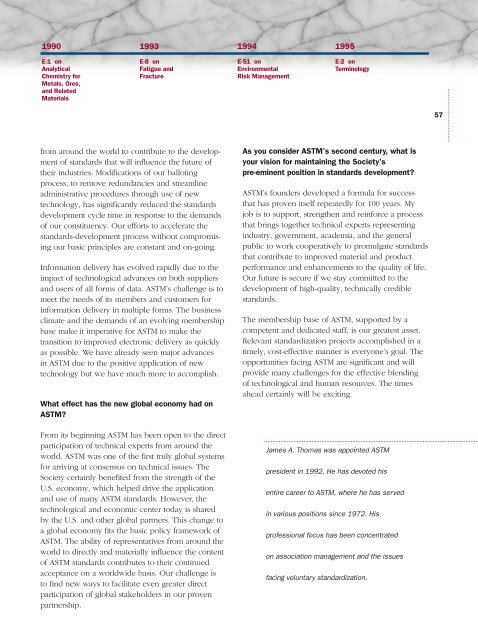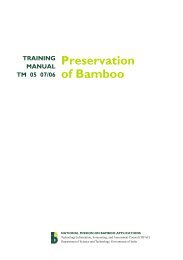ASTM
Create successful ePaper yourself
Turn your PDF publications into a flip-book with our unique Google optimized e-Paper software.
1990<br />
1993<br />
1994<br />
1995<br />
E-1 on<br />
Analytical<br />
Chemistry for<br />
Metals, Ores,<br />
and Related<br />
Materials<br />
E-8 on<br />
Fatigue and<br />
Fracture<br />
E-51 on<br />
Environmental<br />
Risk Management<br />
E-2 on<br />
Terminology<br />
57<br />
from around the world to contribute to the development<br />
of standards that will influence the future of<br />
their industries. Modifications of our balloting<br />
process, to remove redundancies and streamline<br />
administrative procedures through use of new<br />
technology, has significantly reduced the standards<br />
development cycle time in response to the demands<br />
of our constituency. Our efforts to accelerate the<br />
standards-development process without compromising<br />
our basic principles are constant and on-going.<br />
Information delivery has evolved rapidly due to the<br />
impact of technological advances on both suppliers<br />
and users of all forms of data. <strong>ASTM</strong>’s challenge is to<br />
meet the needs of its members and customers for<br />
information delivery in multiple forms. The business<br />
climate and the demands of an evolving membership<br />
base make it imperative for <strong>ASTM</strong> to make the<br />
transition to improved electronic delivery as quickly<br />
as possible. We have already seen major advances<br />
in <strong>ASTM</strong> due to the positive application of new<br />
technology but we have much more to accomplish.<br />
What effect has the new global economy had on<br />
<strong>ASTM</strong>?<br />
From its beginning <strong>ASTM</strong> has been open to the direct<br />
participation of technical experts from around the<br />
world. <strong>ASTM</strong> was one of the first truly global systems<br />
for arriving at consensus on technical issues. The<br />
Society certainly benefited from the strength of the<br />
U.S. economy, which helped drive the application<br />
and use of many <strong>ASTM</strong> standards. However, the<br />
technological and economic center today is shared<br />
by the U.S. and other global partners. This change to<br />
a global economy fits the basic policy framework of<br />
<strong>ASTM</strong>. The ability of representatives from around the<br />
world to directly and materially influence the content<br />
of <strong>ASTM</strong> standards contributes to their continued<br />
acceptance on a worldwide basis. Our challenge is<br />
to find new ways to facilitate even greater direct<br />
participation of global stakeholders in our proven<br />
partnership.<br />
As you consider <strong>ASTM</strong>’s second century, what is<br />
your vision for maintaining the Society’s<br />
pre-eminent position in standards development?<br />
<strong>ASTM</strong>’s founders developed a formula for success<br />
that has proven itself repeatedly for 100 years. My<br />
job is to support, strengthen and reinforce a process<br />
that brings together technical experts representing<br />
industry, government, academia, and the general<br />
public to work cooperatively to promulgate standards<br />
that contribute to improved material and product<br />
performance and enhancements to the quality of life.<br />
Our future is secure if we stay committed to the<br />
development of high-quality, technically credible<br />
standards.<br />
The membership base of <strong>ASTM</strong>, supported by a<br />
competent and dedicated staff, is our greatest asset.<br />
Relevant standardization projects accomplished in a<br />
timely, cost-effective manner is everyone’s goal. The<br />
opportunities facing <strong>ASTM</strong> are significant and will<br />
provide many challenges for the effective blending<br />
of technological and human resources. The times<br />
ahead certainly will be exciting.<br />
James A. Thomas was appointed <strong>ASTM</strong><br />
president in 1992. He has devoted his<br />
entire career to <strong>ASTM</strong>, where he has served<br />
in various positions since 1972. His<br />
professional focus has been concentrated<br />
on association management and the issues<br />
facing voluntary standardization.




